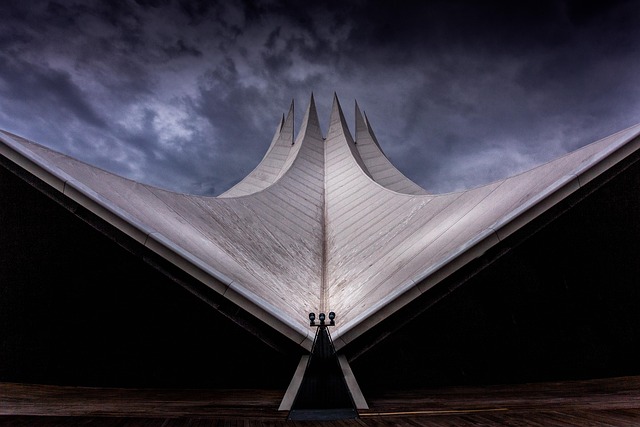In architecture, flat and pitched roof combinations are key to achieving captivating building aesthetics. Flat roofs offer modern minimalism, while pitched roofs provide traditional character. Combining these creates visual interest and stands out in contemporary landscapes. Curved and arched rooflines, trendy in modern design, integrate with flat or pitched roofs for striking contrasts. Strategic material choices, like steel, wood, or composite materials, ensure structural integrity and aesthetic coherence. Real-world examples showcase hybrid designs enhancing user experiences while blending functionality with modern aesthetics, leveraging flat and pitched roof combinations effectively.
“Elevate your modern architecture with a touch of timeless elegance: curved and arched rooflines. This article explores the harmonious blend of traditional and contemporary styles through unique roof designs, offering a fresh perspective on residential and commercial spaces.
We delve into the contrast between flat and pitched roofs, highlighting why their combination can create dynamic aesthetics. From the subtle curve to dramatic arches, discover how these elements enhance design flexibility and create visually stunning structures that defy conventional boundaries.”
Understanding Flat and Pitched Roofs: A Modern Contrast
In architecture, the choice between a flat or pitched roof is a fundamental decision that sets the tone for a building’s overall aesthetic. Flat roofs, characterized by their horizontal lines, offer a sleek and minimalist appeal, often preferred in modern designs aiming for an industrial look. Conversely, pitched roofs with their sloping surfaces create a more traditional and dynamic silhouette, adding depth and character to structures.
When considering a modern aesthetic, combining flat and pitched rooflines can create a captivating contrast. This hybrid approach allows architects to play with light and shadow, providing both open, uncluttered spaces below the flat sections and visually interesting slopes that disrupt the monotony of a uniform exterior. Such variations enrich the building’s profile, making it stand out in contemporary architectural landscapes.
The Appeal of Curved and Arched Rooflines
Curved and arched rooflines have gained significant popularity in modern architecture, offering a compelling alternative to traditional flat or pitched roofs. This aesthetic appeal lies in their ability to create dynamic, visually striking silhouettes that seamlessly blend with contemporary design philosophies. By incorporating these curves, architects can achieve a sense of fluidity and elegance, breaking away from the conventional straight lines often associated with older buildings.
The integration of curved and arched rooflines also provides a unique opportunity for diverse architectural styles. They can be seen in modern houses, from sleek minimalist designs to more ornate structures, creating an intriguing visual contrast when paired with flat or pitched roofs. This versatility allows for innovative design choices, ensuring that homes remain both aesthetically pleasing and functional, catering to the diverse preferences of contemporary homeowners.
Integrating Architectural Styles: Design Considerations
When incorporating curved or arched rooflines for a modern aesthetic, architects must carefully integrate these elements with existing architectural styles. One popular approach involves blending flat and pitched roof combinations, creating a harmonious design that marries traditional and contemporary elements. This can be achieved by aligning curved roofs with straight lines, forming a visually appealing contrast that adds depth to the building’s silhouette.
Design considerations include matching the scale and proportion of different roof types. For instance, a small, gracefully arched roof over a side wing can complement a larger, flat roof spanning the main structure. Textures and materials also play a crucial role; using contrasting yet complementary finishes can enhance the overall aesthetic, such as pairing metal panels with brick or wood cladding. This thoughtful integration ensures that the curved rooflines not only enhance the modern appeal but also contribute to the building’s overall architectural coherence.
Material Choices for Bespoke Roof Aesthetics
When incorporating curved or arched rooflines for a modern aesthetic, material choices play a crucial role in achieving a unique and visually appealing design. Beyond traditional flat and pitched roof combinations, architects and builders now have a plethora of options to suit various architectural styles and preferences. Materials like steel offer both structural integrity and the ability to create dynamic, organic shapes that complement curved roofs. For a more natural look, wood shakes or tiles can add warmth and texture, while still allowing for intricate curvature. Additionally, modern composite materials combine the best properties of different substances, providing durability, low maintenance, and customizable aesthetics. These options enable designers to blend seamlessly with surrounding landscapes or create bold, contrasting statements that define a building’s character.
Real-World Examples: Embracing the Hybrid Look
Incorporating curved or arched rooflines into modern architecture offers a compelling blend of aesthetics and functionality, creating what we term a “hybrid look.” Real-world examples abound in contemporary designs that seamlessly merge flat and pitched roof combinations. For instance, many mid-century modern homes feature low-slung, flat roofs punctuated by dramatic, curved elements—such as overhangs or accent walls—that add visual interest while maintaining a sleek silhouette.
This hybrid approach isn’t limited to residential settings; commercial buildings and public spaces also embrace the style. Think of a museum with a soaring, curved glass roof or an office complex that uses arched walkways to connect diverse areas. These designs not only capture the essence of modern aesthetics but also invite occupants and visitors alike to experience spaces in novel ways, enhancing the overall user experience.
Incorporating curved or arched rooflines offers a striking modern aesthetic, bridging the gap between traditional flat and pitched roofs. By understanding the contrast these designs create and carefully integrating architectural styles, material choices can enhance any space. The real-world examples showcased demonstrate the versatility of this hybrid approach, where flat and pitched roof combinations result in unique, eye-catching structures that blend timeless elegance with contemporary flair.
